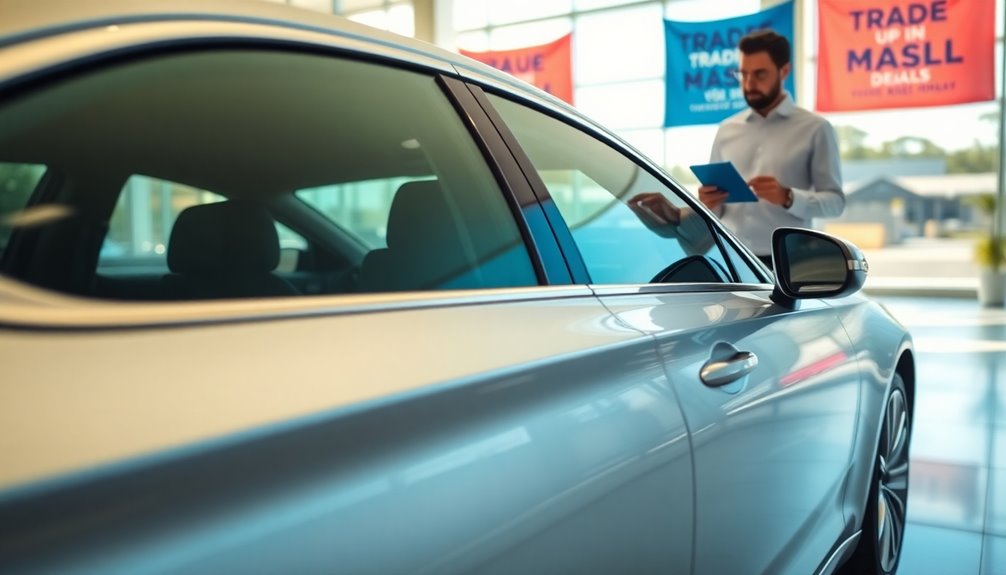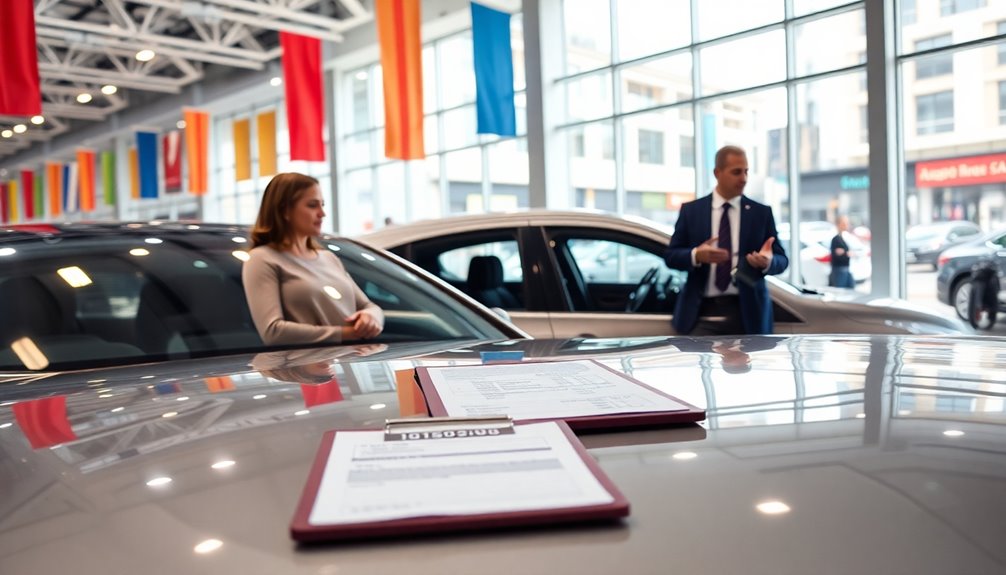To trade your leased car at another dealership, start by reviewing your lease agreement for any restrictions. Assess your vehicle's market value using tools like Kelley Blue Book to understand your equity. Contact your leasing company for a buyout quote, and take into account any fees they may charge. Research dealerships that accept leased vehicle trades and gather competing quotes for leverage. Prepare necessary documents, like your lease agreement and maintenance records, before negotiating. Remember, leveraging your vehicle's equity can greatly impact your next purchase. There's a lot more to reflect on, so keep exploring your options to maximize your trade-in value.
Key Takeaways
- Verify your lease agreement for any restrictions on trading the vehicle at another dealership, including third-party buyout clauses.
- Obtain a payoff quote from your leasing company to understand the buyout price and any additional fees involved.
- Research and compare trade-in values using tools like Kelley Blue Book to assess potential equity or loss before negotiating.
- Contact multiple dealerships to gather trade-in quotes and find those that specialize in lease buyouts for better offers.
- Prepare necessary documentation, including your lease agreement, vehicle history report, and maintenance records, to support your trade-in.
Understanding Lease Agreements
When it comes to trading a leased car, understanding lease agreements is key to making informed decisions. These contracts outline your rights and responsibilities as a lessee, including monthly payments, mileage limits, and your options at the lease's end. Typically, you'll have three choices: buy the vehicle at its residual value, return it, or trade it in at another dealership.
Before you decide, it's essential to review your lease agreement closely. Check for any restrictions on trading in your vehicle, as some manufacturers may limit this option to specific dealerships.
Also, be aware of potential fees for excess wear and mileage penalties that could impact your decision.
Understanding the residual value is especially important. This predetermined buyout price helps you evaluate whether trading in the vehicle makes financial sense. If the market value is higher than the residual value, you might've equity to use towards your next car.
Assessing Vehicle Value

To effectively assess your leased vehicle's value, start by utilizing online appraisal tools like Kelley Blue Book or Edmunds. These platforms provide estimates based on current market conditions and your vehicle's specifics, helping you determine its appraisal value.
Next, compare this appraised value to the residual value outlined in your lease agreement. This comparison will show you whether you have potential equity or a loss. Pay close attention to factors like your vehicle's condition, mileage, and any modifications, as these can greatly influence its resale or trade-in value. Additionally, understanding the tax implications of your lease buyout can aid in making a more informed decision. It's also beneficial to consider the concept of diversification in your overall financial strategy, as investing in different assets can help mitigate risks associated with vehicle ownership. Regularly evaluating your vehicle's condition can also help you stay informed about its market value.
Consider obtaining a vehicle history report to uncover any past accidents or issues that might affect its market value. This information will also strengthen your negotiation position.
Additionally, keep an eye on current market trends. Supply chain issues can inflate used vehicle prices, potentially increasing the trade-in value of your leased car. Furthermore, being aware of local store hours can also assist in planning your shopping trips around vehicle-related needs, such as extended hours for convenience.
Lease Buyout Process

If you're considering buying out your leased car, understanding the lease buyout process is essential. This process typically involves purchasing your leased vehicle at its predetermined residual value, as outlined in your lease contract.
Start by contacting your leasing company to request the buyout price and check for any additional fees or charges that may apply.
Once you have the buyout price, compare it to the vehicle's current market value. You can use online tools like Kelley Blue Book or Edmunds to get an accurate assessment.
If the buyout price is lower than or comparable to the market value, it might be a good deal.
If you decide to proceed with the buyout, you'll need to secure financing for the residual value along with sales tax and any other associated costs.
Before finalizing anything, review your lease contract for any specific conditions regarding buyouts, especially if you're considering a third-party buyout, as some manufacturers may impose restrictions.
Finding a Willing Dealership

Finding a willing dealership for your leased car is vital if you're looking to trade it in. Not every dealership participates in lease buyouts, so you'll need to do some research. Start by contacting multiple dealerships to compare their willingness to handle your trade-in.
Here are some key points to take into account:
- Specialization: Some dealerships specialize in lease buyouts, which can give you more flexibility in negotiations.
- Policies: Always check the dealership's policies regarding leased vehicle trade-ins; procedures can vary widely.
- Leaseholder Approval: Verify your leasing company allows for third-party buyouts, as this can impact whether another dealership can take over your lease.
When you're finding a dealer willing to work with your leased vehicle, don't hesitate to reach out to your leaseholder for guidance. They can provide essential information about your lease's terms and whether you can proceed with trading your car at another dealership to buy.
Evaluating Financial Implications

When you're trading in a leased vehicle, you need to assess the lease buyout price and compare it to the trade-in value.
This comparison helps you understand if you have any equity or if you might incur a loss. Knowing your vehicle's current market value will also guide your negotiations and financial decisions.
Assessing Lease Equity
Understanding lease equity is essential for anyone considering trading in a leased vehicle. Lease equity refers to the difference between your vehicle's market value and its lease buyout price. If your car's market value exceeds the buyout price, you have positive equity, which can be beneficial when trading it in.
Here's how to assess your lease equity effectively:
- Use valuation tools like Kelley Blue Book or Edmunds to find your vehicle's current market value.
- Compare this market value with the lease buyout price outlined in your lease agreement.
- Determine if you have positive equity, negative equity, or if they're roughly equal.
If you discover that you have lease equity, you can apply it as a down payment on your next vehicle, reducing your overall financing costs or monthly payments.
Conversely, if your lease buyout price is higher than the trade-in value, you might face negative equity, meaning you'll need to cover the difference to make a new purchase feasible.
Trade-In Value Comparison
Comparing the trade-in value of your leased car with the lease buyout price is essential for making sound financial decisions. This comparison helps you understand your financial position and whether you can benefit from positive equity. You can use tools like Kelley Blue Book or Edmunds to determine your car's fair market value. When the trade-in value exceeds the lease buyout price, you gain positive equity, which can reduce costs for your next vehicle.
It's wise to gather quotes from multiple dealerships, as trade-in values will vary considerably. Also, consider any penalties for excess mileage or wear and tear, as these can impact your overall financial outcome.
Here's a quick comparison table to illustrate the trade-in value versus lease buyout price:
| Item | Amount |
|---|---|
| Lease Buyout Price | $20,000 |
| Trade-In Value | $22,500 |
| Positive Equity | $2,500 |
| Potential Costs | $1,000 (penalties) |
| Net Benefit | $1,500 |
Comparing Buyout and Trade-In Values

Evaluating the buyout and trade-in values of your leased car is essential for making a smart financial decision. Start by checking your lease contract for the predetermined buyout price, which is the amount needed to purchase your leased vehicle.
Next, compare this buyout price with the current trade-in value. A favorable trade-in value can greatly impact your finances, potentially offsetting buyout costs.
Here are some key points to take into account:
- If the buyout price is higher than the trade-in value, some dealerships might allow you to roll the excess costs into a new lease or purchase agreement.
- The wholesale value of your leased vehicle can serve as trade credit, but be wary of potential termination charges that may affect your overall financial outcome.
- Consulting with finance managers at dealerships can clarify your options and help you navigate the complexities of buyout versus trade-in values.
Navigating Different Brands

When you're ready to switch brands, you'll find plenty of flexibility in trading your leased vehicle.
Many dealerships offer enticing incentives for making the leap, so it pays to explore your options.
Just make sure to review your lease contract for any restrictions before jumping into the trade-in process.
Brand Flexibility Benefits
One of the biggest perks of trading in a leased vehicle is the freedom to switch brands without hassle. Since the leasing bank holds the lease, you can easily trade in your leased vehicle at any dealership that's willing to negotiate the lease buyout. This opens up a world of possibilities when exploring new cars.
Here are a few benefits of brand flexibility:
- Incentives and Discounts: Many dealerships offer special promotions for customers looking to trade in their leased vehicles for a different brand.
- Competitive Offers: Since various dealerships specialize in lease buyouts, you can shop around for the best deal, maximizing your trade-in value.
- Simplified Changeover: Trading in your leased vehicle can help you avoid excess mileage or wear-and-tear fees, making the switch to a new brand smoother.
When you decide to trade in your leased vehicle, you're not just getting a new car; you're also enjoying the advantages that come with brand flexibility.
Trade-In Process Steps
Trading in a leased car involves several important steps, especially when maneuvering different brands. Start by reviewing your lease agreement for any restrictions regarding third-party buyouts. Understanding the buyout price set by the leasing company is essential, so contact them to get the current payoff amount. This figure will be important during negotiations with the dealership.
Next, visit multiple dealerships to compare trade-in values, as each will assess your vehicle differently based on market conditions. It's critical to choose a dealership that's willing to handle the trade-in process, as not all dealerships are equipped to buy out leases from other banks.
While evaluating offers, be mindful of potential fees associated with excess wear and tear or mileage overages. These factors can greatly impact your overall trade-in value, so factor them into your decision-making process.
Once you've gathered all necessary information and offers, you'll be ready to make an informed choice that maximizes your benefits when trading in your leased car.
Preparing for Negotiations

Before diving into negotiations for your leased car, it's vital to arm yourself with the right information. Start by reviewing your lease agreement to pinpoint the lease buyout quote and any clauses regarding third-party dealership transactions. This knowledge will empower you in discussions.
Next, obtain a vehicle appraisal from resources like Kelley Blue Book or Edmunds. Understanding the fair market value of your car is fundamental for effective negotiation. Additionally, reach out to multiple dealerships to gather buyout offers. This will give you leverage when the time comes to negotiate.
Here's what you should prepare:
- Documentation: Have your lease agreement, payoff quote from the leasing company, and vehicle maintenance records ready.
- Awareness: Be cognizant of potential fees for excess mileage or wear-and-tear that could affect your trade-in value.
- Offers: Collect competing buyout offers to bolster your negotiating position.
Armed with this information, you'll be better positioned to negotiate a favorable outcome for your leased car. Remember, preparation is key to ensuring you maximize your trade-in value!
Managing Paperwork and Documentation

Managing the paperwork and documentation for your leased car is crucial to a smooth trade-in process. Start by gathering key documents, including your lease agreement, registration, and proof of insurance. These pieces of paperwork will help streamline negotiations with the dealership.
Next, obtain a payoff quote from your leasing company. This quote will outline the remaining balance owed on the lease, which is essential for determining your trade-in valuation. Additionally, collect documentation regarding your vehicle's condition, such as maintenance records and a vehicle history report. This information can greatly support your trade-in valuation.
Don't forget to check the specifics of any third-party buyout clauses in your lease contract. This step can prevent complications during the trade-in. Finally, be ready to present the original title and any other necessary documents when finalizing the transaction.
Here's a helpful overview of what you'll need:
| Document Type | Purpose | Notes |
|---|---|---|
| Lease Agreement | Confirms terms of lease | Crucial for trade-in process |
| Payoff Quote | Shows remaining lease balance | Important for negotiation |
| Maintenance Records | Proves vehicle condition | Supports trade-in valuation |
| Vehicle History Report | Details past accidents or issues | Enhances credibility |
| Original Title | Required for finalizing trade-in | Check for any additional documents |
Seeking Expert Assistance

When you're ready to trade in your leased car, seeking expert assistance can really make a difference.
Dealership finance teams can guide you through lease termination, assess your vehicle's trade-in value, and offer valuable financing tips.
Lease Termination Guidance
Maneuvering the lease termination process can be complex, and seeking expert assistance is essential to guarantee you make informed decisions.
Understanding your lease contract is important, as it may contain clauses that restrict third-party buyouts. Engaging professionals can clarify the lease termination guidance you need.
Here are three key areas where expert help can benefit you:
- Understanding penalties: Dealership finance departments can explain any potential penalties linked to early termination.
- Determining residual value: A financial expert can provide insights into the residual value of your leased vehicle, which is important for negotiating trade-in offers.
- Facilitating communication: Many dealerships will contact the leasing company on your behalf to determine payoff amounts and any incurred fees.
Trade-In Value Assessment
To effectively assess the trade-in value of your leased car, seeking expert assistance can make a significant difference.
Start by consulting reputable vehicle appraisal tools like Kelley Blue Book or Edmunds. These resources help you determine the market value of your car compared to the lease buyout price. It's essential to obtain a lease buyout quote from your leasing company, as this will indicate whether the trade-in value exceeds the buyout price, potentially resulting in positive equity.
When you visit a dealership, they may offer to appraise your vehicle, providing a direct comparison to the residual value outlined in your lease agreement.
Take advantage of this opportunity to understand how your car's condition affects its trade-in value. Significant wear and tear or mileage overages can lower the value and impact any fees at lease termination.
Engaging with finance managers at the dealership can also clarify your options. They can explain how trade-in credits may apply toward a new lease or purchase and whether any excess costs from the buyout can be rolled into a new financing plan.
This informed approach guarantees you maximize your trade-in experience.
Financing and Negotiation Tips
Having a clear understanding of your trade-in value lays the groundwork for effective financing and negotiation. Before heading to the dealership, gather your lease agreement to confirm the lease buyout price and any potential penalties for early termination.
Research your leased vehicle's current market value using tools like Kelley Blue Book or Edmunds to strengthen your negotiation position and avoid being lowballed.
Here are a few tips to enhance your negotiation:
- Contact multiple dealerships for trade-in quotes; different dealers may offer varying values based on their inventory needs.
- Discuss any equity in your lease, as it can greatly influence financing options.
- If you're unsure about financial implications, consult with a finance manager to explore rolling over remaining lease payments into a new lease or purchase.
Being prepared to discuss your financial goals will help you navigate the negotiation process more effectively.
The more informed you are, the better position you'll have to negotiate a favorable deal. Remember, knowledge is key to getting the best value for your leased vehicle.
Frequently Asked Questions
How Does Trading in a Leased Car Work?
Trading in a leased car involves your dealership paying off the remaining lease balance directly to the leasing company.
You'll need to gather necessary documents like your lease agreement and vehicle info to facilitate the process.
The dealership assesses your car's condition and market value to determine the trade-in credit.
If the trade-in value is higher than the lease payoff, you can apply the excess towards a new vehicle, easing your financial burden.
What if My Leased Car Is Worth More Than Residual?
If your leased car's worth more than its residual value, you've hit the jackpot!
This positive equity can act like a golden ticket, letting you apply that extra value towards a new vehicle.
You'll want to let the dealership know about your car's market value to negotiate better terms.
Plus, some dealerships might let you roll that equity into your new lease, making your shift smoother and potentially saving you money!
What's the Earliest You Can Return a Leased Car?
The earliest you can return a leased car usually depends on your lease agreement.
Most leases require you to keep the vehicle for at least six to twelve months.
If you want to return it early, be prepared for potential fees, including early termination charges.
It's a good idea to check with your leasing company for any specific policies or incentives they might offer for early returns, especially if you're a repeat customer.
How Does Equity in a Leased Car Work?
Equity in a leased car refers to the value difference between what the car's worth in the market and what you still owe on the lease.
If your car's market value is higher than its residual value, you've got positive equity, which can be beneficial for your next vehicle.
On the other hand, negative equity means you owe more than the car's worth, potentially complicating your leasing or buying options.
Always assess your equity before making decisions.
Conclusion
Trading your leased car at another dealership can be a smooth ride if you follow the right steps. Just remember, knowledge is your best co-pilot. By understanding your lease, evaluating your vehicle's value, and preparing for negotiations, you're setting yourself up for success. Don't hesitate to seek expert help if needed; it's like having a GPS on a road trip—essential for reaching your destination without getting lost. Happy trading!









